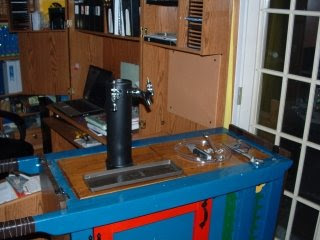As promised, here are some photos of my new stirplate:
This is it, in 90% of its glory. A few salient features to note: The knob on the far right controls the speed. The red switch in the center is power on/off (it lights up when on). The jack on the left-facing side is for the wall-jack.
Here, you see said wall-jack. I haven’t yet firmed up the split in the cable with electrical tape, but that’s not going to be either difficult or time-consuming.
Here it is, stirring away (at some water), full-bore. Note the nice whirlpool developed in the center. You can just make out the spinning white stir-bar at the bottom of the flask. Also, note the beautifully lit power switch. 🙂
All told, I don’t think this even cost me $20 to make. The computer fan (the actual “driving force”, if you will) was salvaged from a dead desktop computer. The enclosure I had purchased for another project, but subsequently realized was too small. I had the AC adapter from my other project (the HERMs Rig Controller), and only needed a female jack. The jack, switch, potentiometer, and knob I got at Radio Shack for under $10. Simplicity, itself.
I hope this has inspired you to make your own stirplate! I’ve certainly been bit with the do-it-yourself bug, after this. There’s nothing like having a completed project, functional, made by your own hands, to make you want to create.


